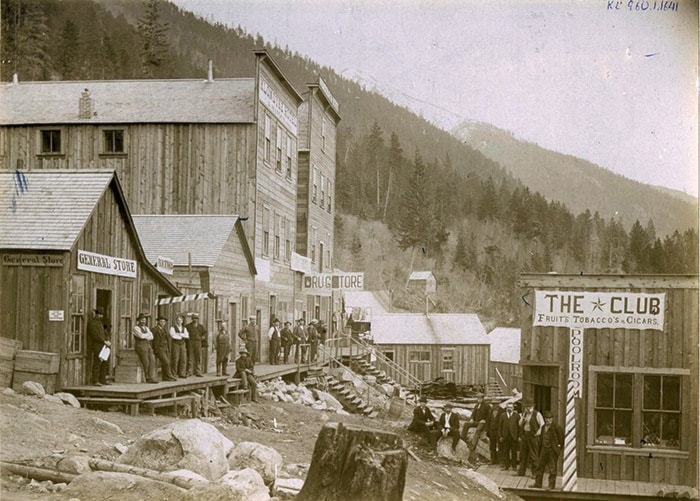A mystery photo in the Kootenay Lake Archives labelled Three Forks turns out to be a rare view of the boom town of Kuskonook in 1898. Or so I think.
The dry-mounted picture shows several wooden commercial buildings on an embankment with a boardwalk and two sets of stairs in front.
The buildings include a general store, drug store, tobacconist/poolroom/fruit stand called The Club and two multi-storey hotels — the sign on one reads “Klondyke Hotel, A. Manson, Prop.”
There’s a big stump and some boulders in the foreground and forested mountains in the background. At least 20 men pose on the street.
A handwritten label at the bottom says “Three Forks, BC, 1892” but someone crossed it out and wrote “Ainsworth” — only to cross it out again and restore it to Three Forks.
No photographer is indicated.
Kootenay Lake archivist Elizabeth Scarlett says the photo’s provenance is unknown because the historical society acquired it before the archives was established.
The picture intrigued Victoria researcher Peter Smith, who notes first of all that the date is almost certainly wrong. Klondyke (or Klondike) hotels only started sprouting up after the Yukon gold rush began in 1897.
Secondly, there was no Klondyke Hotel in Three Forks, a ghost town in the Slocan, although there were ones in Sandon, Nelson, and Robson.
A. Manson, however, was not the proprietor of those although he did run the Grove Hotel in Nelson for a while. On the 1898 BC voters list, Alfred Manson is listed as a hotelier in Kuskonook, and indeed, the civic directory for that year shows he ran a Klondyke Hotel there.
Kuskonook, on the east shore of Kootenay Lake, came to life during construction of first the BC Southern Railway and then the Bedlington and Nelson Railway. It was a rough place, with several saloons and at least one murder.
Beyond the hotel, however, there isn’t much else to verify the photo as Kuskonook. A sign above the drug store appears to read in part “—TERS.” In 1898, the town druggist was James M. Patterson. Might that sign have borne his name?
The photo isn’t immediately recognizable as Kusknonook because it doesn’t show Kootenay Lake, which is presumably off camera range to the right. Also, hardly any photos of Kuskonook exist.
Tammy Hardwick of the Creston Museum said she is only aware of one in the BC Archives, also believed to have been taken about 1898. It does show the lake but none of the buildings appear to match.
Kuskonook burned down on March 21, 1900, including more than 30 homes. Most were unoccupied, but the remaining residents were left destitute. A relief committee was organized in Nelson to help them.
Nelson city councillor Robin Cherbo has a strong connection to old Kuskonook — his grandfather Pedro Cherbo was co-proprietor with Gimmi Mannerino of the Union Hotel, one of only three buildings to survive the fire.
Cherbo maintains a mining claim his grandfather staked in the area, the Osprey No. 1, and has a few old documents and early letterheads, but alas, no photos.
The naming of Kuskonook is confusing and complex, but it is derived either from a Salish term meaning “long point” or a Ktunaxa term meaning “edge or end of lake.” It is also written Kuskanook, which is how the CPR spelled it when it launched a sternwheeler by that name in 1906.

You can see Kuskonook on a map below.
